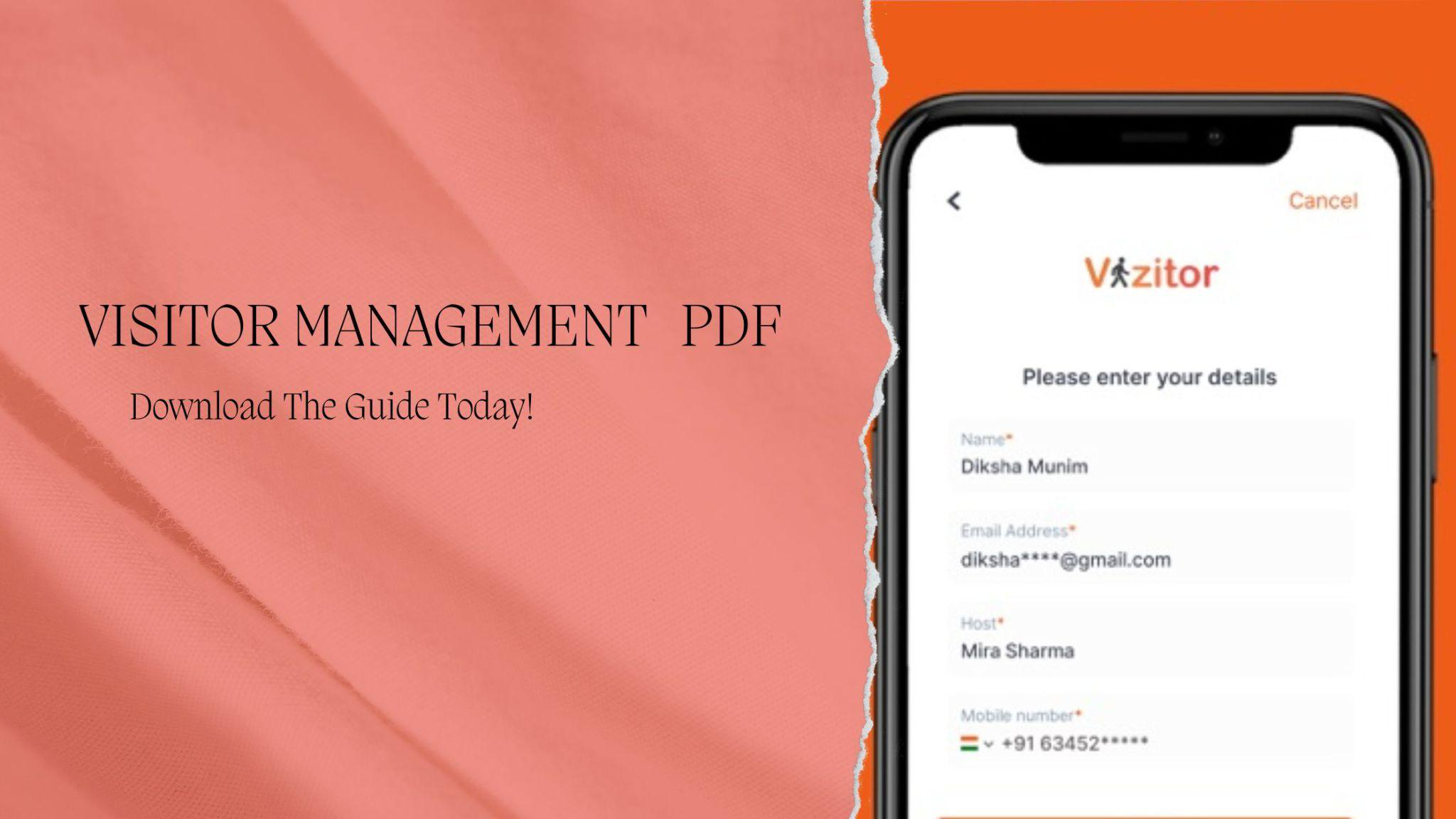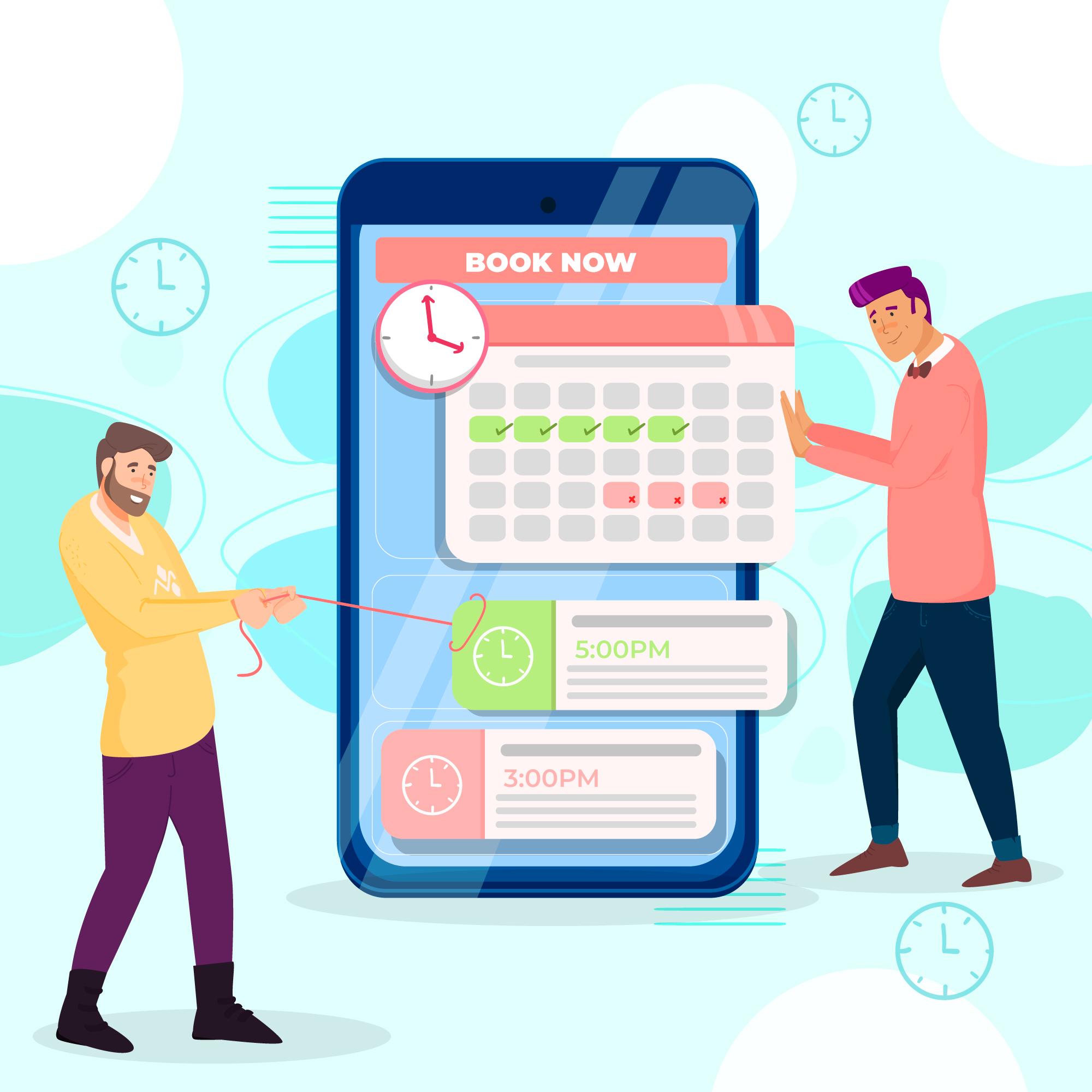Table of Content
Try Vizitor for Free!

Thu, Jul 18, 2024
Read in 16 minutes
Introduction
Choosing the right Visitor Management System (VMS) is crucial for businesses aiming to enhance security, streamline operations, and provide a welcoming environment for guests. Whether you manage a corporate office, educational institution, or healthcare facility, selecting a VMS tailored to your specific needs can significantly impact efficiency and safety protocols. This PDF guide is designed to equip decision-makers with essential insights into navigating the complexities of VMS selection.
From understanding the basic functionalities to evaluating advanced features like integration capabilities and data analytics, this guide will outline key considerations. Additionally, it will explore the importance of compliance with industry regulations such as GDPR or HIPAA, ensuring that your chosen VMS aligns with legal requirements.
Did you know? In 2023, the global market for Visitor Management Systems was projected to grow at a compound annual growth rate (CAGR) of over 15%, reflecting increasing adoption across various sectors worldwide. This growth underscores the rising importance of VMS in modern business operations, driven by heightened security concerns and the need for seamless visitor experiences.
How Does Visitor Management System Help Business?
Managing visitor flow and ensuring security can be challenging in today’s fast-paced business environment. Traditional sign-in methods are often inefficient, error-prone, and lack the necessary features to address modern security concerns.
Businesses face issues like unauthorized access, long wait times for visitors, and inadequate record-keeping, which can lead to compliance violations and security breaches. A Visitor Management System (VMS) offers a comprehensive solution to these problems, providing a seamless, secure, and efficient way to manage visitors.
Why do Businesses Choose Visitor Management?
Enhanced Security: A VMS ensures that only authorized individuals enter the premises by verifying visitor credentials and maintaining accurate records. This reduces the risk of unauthorized access and enhances overall security.
Efficient Check-In Process: Automating the Visitor Check-in process with a VMS minimizes wait times and improves the visitor experience. Pre-registration options and self-service kiosks streamline entry procedures.
Regulatory Compliance: Many industries are required to maintain detailed visitor logs. A VMS automates this process, ensuring compliance with regulations such as GDPR and HIPAA.
Data Insights: A VMS provides valuable data on visitor patterns and trends, enabling businesses to make informed decisions about resource allocation and operational improvements.
How Visitor Management System Has Helped Businesses:
Increased Efficiency: By automating visitor management, businesses have significantly reduced administrative workload, allowing staff to focus on more critical tasks.
Improved Security Measures: Companies have reported fewer security incidents and better control over visitor access.
Enhanced Visitor Experience: Visitors enjoy a smoother, quicker check-in process, positively reflecting the business’s reputation.
Overall, a Visitor Management System addresses key business challenges, ensuring a safer, more efficient, and professional environment for both employees and visitors.
Key Features to Look For The Best Visitor Management System
When selecting the best Visitor Management System (VMS), consider the following key features to ensure it meets your organization’s needs:
User-Friendly Interface
Intuitive design for easy navigation by both staff and visitors.
Simple check-in and check-out process.
Pre-Registration Capability
Allow visitors to pre-register online before their visit.
Send automatic email or SMS invitations with QR codes for fast check-in.
Security and Compliance
ID verification and photo capture.
Integration with watchlists for security screening.
Compliance with data privacy regulations (e.g., GDPR, CCPA).
Customizable Visitor Badges
Ability to print visitor badges with photo, name, visit purpose, and visit duration.
Customizable templates to match your branding.
Visitor Data Management
Secure storage of visitor data with encryption.
Easy retrieval and reporting of visitor logs.
Integration with Other Systems
Compatibility with access control systems, meeting room management, and other enterprise systems.
API access for custom integrations.
Real-Time Notifications
Instant notifications to hosts upon visitor arrival.
Alerts for unauthorized access attempts.
Self-Service Kiosks
Touchscreen kiosks for self-check-in to reduce reception workload.
Multilingual support for diverse visitor demographics.
Emergency Management
Quick access to visitor logs for emergency evacuations.
Ability to send mass notifications to visitors and staff during emergencies.
Analytics and Reporting
Detailed insights and analytics on visitor trends and patterns.
Customizable reports for auditing and compliance purposes.
Mobile Accessibility
Mobile app for hosts to manage visitor arrivals and pre-registration.
Visitors self-check in via mobile devices.
Scalability
Ability to handle high visitor volumes and multiple locations.
Flexible plans to accommodate organizational growth.
Technical Support and Training
Reliable customer support and troubleshooting assistance.
Training resources for staff and administrators.
Digital Signatures
Capture digital signatures for visitor agreements, NDAs, or consent forms.
Store signed documents securely in the system.
Touchless Check-In Options
Enable touchless check-in using QR codes or mobile devices to reduce contact points.
NFC (Near Field Communication) and Bluetooth options for enhanced convenience.
Host Management
Allow hosts to schedule appointments and pre-register visitors.
Hosts can receive reminders and updates about their scheduled visitors.
Visitor Feedback
Collect visitor feedback through surveys or rating systems.
Analyze feedback to improve visitor experiences and processes.
Integration with Calendar Systems
Sync with popular calendar systems like Outlook, Google Calendar, and others.
Automatic updates and reminders for hosts and visitors.
Customization and Branding
Customizable interface to reflect your organization’s branding.
Personalized welcome messages and screen displays.
Wi-Fi Access Management
Provision temporary Wi-Fi access to visitors.
Automated credentials issuance and management.
Multitenancy Support
Manage multiple tenants or departments within a single system.
Separate dashboards and reports for each tenant or department.
Hardware Compatibility
Support for various hardware like badge printers, ID scanners, and cameras.
Compatibility with existing infrastructure to minimize additional costs.
Visitor Experience Enhancement
Interactive maps and wayfinding assistance for visitors.
Personalized visitor experience based on visit history or preferences.
Sustainability Features
Digital record-keeping to reduce paper waste.
Energy-efficient hardware options.
Multi-Location Management
Centralized control for organizations with multiple locations.
Consistent visitor policies and procedures across all sites.
Access Control Integration
Seamless integration with physical access control systems.
Automated access permissions based on visitor type and visit purpose.
Blacklist/Whitelist Management
Maintain and manage lists of banned or preferred visitors.
Automatic alerts for attempts by blacklisted individuals.
Visitor History Tracking
Detailed logs of past visits for security and compliance audits.
Easy access to historical visitor data.
Localization and Language Support
Support for multiple languages to accommodate international visitors.
Localization features to adapt to different regional requirements.
Cost-Effectiveness
Clear pricing structure with no hidden fees.
Scalable options that provide good value for the features offered.
Steps to Choose the Right Visitor Management System
Choosing the right Visitor Management System (VMS) involves a thorough evaluation of your organization’s needs and the features offered by different systems. Here are the steps to guide you through the selection process:
Assess Your Organization’s Needs
Identify Requirements: Determine the specific needs of your organization. Consider the volume of visitors, security requirements, compliance regulations, and visitor experience expectations.
Stakeholder Input: Gather input from key stakeholders, including security, IT, reception staff, and department heads, to understand their needs and concerns.
Set a Budget
Cost Considerations: Establish a budget for the VMS. Consider both initial setup costs and ongoing expenses, including software licenses, hardware, and maintenance.
Return on Investment: Evaluate the potential return on investment by considering improvements in efficiency, security, and visitor experience.
Research and Shortlist Vendors
Market Research: Conduct thorough research to identify potential VMS vendors. Look for industry leaders and systems that have positive reviews and testimonials.
Feature Comparison: Compare the features of different systems against your requirements. Create a shortlist of vendors that offer the features you need.
Request Demos and Trials
Product Demos: Schedule demos with shortlisted vendors to see the systems in action. Pay attention to the user interface, ease of use, and key functionalities.
Free Trials: Take advantage of free trials to test the system in your environment. Engage staff in the trial to get their feedback and assess the system’s performance.
Evaluate System Compatibility
Integration with Existing Systems: Ensure the VMS can integrate with your existing systems, such as access control, calendars, and HR systems.
Hardware Compatibility: Check compatibility with existing hardware, such as badge printers, ID scanners, and kiosks, to minimize additional costs.
Check Security and Compliance
Data Security: Verify the system’s data security measures, including encryption, secure storage, and access controls.
Regulatory Compliance: Ensure the system complies with relevant data privacy and security regulations (e.g., GDPR, CCPA).
Assess Customization and Scalability
Customization Options: Look for systems that offer customization options to match your branding and specific needs.
Scalability: Ensure the system can scale with your organization’s growth and handle increased visitor volumes.
Review Support and Training
Customer Support: Evaluate the vendor’s customer support services, including availability, responsiveness, and expertise.
Training Resources: Check if the vendor provides training resources, such as manuals, videos, and onsite training, to help staff learn and use the system effectively.
Analyze Cost and Value
Cost Breakdown: Get a detailed cost breakdown from vendors, including any hidden fees or additional charges.
Value Proposition: Assess the overall value offered by the system in terms of features, benefits, and long-term savings.
Make a Decision and Plan Implementation
Final Decision: Based on your evaluation, choose the VMS that best meets your needs and offers the best value.
Implementation Plan: Develop an implementation plan, including timelines, responsibilities, and milestones. Ensure a smooth transition by involving relevant stakeholders and providing necessary training.
Monitor and Evaluate
Performance Monitoring: After implementation, continuously monitor the system’s performance and gather feedback from users.
Periodic Reviews: Conduct periodic reviews to assess the system’s effectiveness and make necessary adjustments or upgrades.
Comparison of Top Visitor Management Systems
Vizitor
Features: Pre-registration, touchless check-in, digital signatures, visitor badges, real-time notifications, analytics, and integration with access control systems.
Pros: User-friendly interface, customizable branding, strong data security, excellent customer support.
Cons: This may require additional hardware investment for optimal use.
Ideal For: Small to large businesses, corporate offices, and institutions needing robust security and a seamless visitor experience.
Envoy
Features: Visitor registration, badge printing, host notifications, legal document signing, health questionnaires, and visitor insights.
Pros: Comprehensive feature set, easy to use, integration with various apps and systems.
Cons: Higher cost for premium features.
Ideal For: Companies of all sizes looking for a high-end VMS with extensive features.
Proxyclick
Features: Visitor pre-registration, check-in, badge printing, notifications, access control integration, and visitor reporting.
Pros: Highly customizable, excellent security features, GDPR compliance.
Cons: Can be complex to set up and configure.
Ideal For: Large enterprises with specific security and compliance needs.
Traction Guest
Features: Enterprise-grade security, visitor pre-registration, digital document signing, customizable workflows, and detailed analytics.
Pros: Strong focus on security and compliance, highly customizable.
Cons: Higher price point, complex setup.
Ideal For: Large organizations with strict security requirements.
SwipedOn
Features: Visitor sign-in, badge printing, employee in-out tracking, delivery management, and visitor reporting.
Pros: Easy to use, cost-effective, good customer support.
Cons: Limited advanced features.
Ideal For: Small to medium-sized businesses looking for a simple, effective Visitor Management System.
The Receptionist
Features: Visitor check-in, badge printing, notifications, delivery management, and visitor logs.
Pros: User-friendly, excellent customer support, affordable pricing.
Cons: Basic feature set compared to some competitors.
Ideal For: Small to medium-sized businesses.
Sine
Features: Visitor and contractor management, pre-registration, compliance management, mobile app, and real-time notifications.
Pros: Versatile, mobile-friendly, strong compliance features.
Cons: Can be expensive for smaller businesses.
Ideal For: Industries with high compliance needs, such as construction and healthcare.
HID SAFE
Features: Visitor registration, badge printing, identity verification, watchlist screening, and access management.
Pros: Excellent security features, and integration with physical access systems.
Cons: Complex and pricey, suited for high-security environments.
Ideal For: Large enterprises and government institutions with stringent security requirements.
WhosOnLocation
Features: Visitor, contractor, and employee management, emergency management, pre-registration, and badge printing.
Pros: Comprehensive features, strong security, and emergency management.
Cons: The user interface could be more intuitive.
Ideal For: Organizations needing a versatile system for managing various types of visitors and contractors.
iLobby
Features: Visitor pre-registration, check-in, badge printing, compliance tracking, and real-time notifications.
Pros: Easy to use, robust security, scalable.
Cons: Can be expensive for smaller companies.
Ideal For: Medium to large organizations looking for a scalable and secure Visitor Management System.
Veristream
Features: Visitor registration, ID scanning, badge printing, pre-registration, and security alerts.
Pros: Strong focus on security, good customer support.
Cons: The interface could be more modern.
Ideal For: Organizations prioritizing security and visitor screening.
Lobbytrack
Features: Visitor check-in, ID verification, badge printing, watchlist integration, and visitor tracking.
Pros: Affordable, easy to set up, good basic features.
Cons: Limited advanced features and integrations.
Ideal For: Small businesses or offices needing a simple Visitor Management System.
Common Mistakes to Avoid While Choosing A Visitor Management System
When choosing a Visitor Management System (VMS), it’s important to avoid common mistakes that can lead to inefficiencies, increased costs, or security vulnerabilities. Here are some common pitfalls to watch out for:
Not Assessing Specific Needs
Mistake: Choosing a VMS without a clear understanding of your organization’s specific requirements.
Avoidance: Conduct a thorough needs assessment involving all stakeholders to determine essential features and functionalities.
Overlooking User Experience
Mistake: Selecting a system that is difficult for visitors and staff to use.
Avoidance: Opt for a user-friendly interface with intuitive navigation. Consider systems with positive user feedback regarding ease of use.
Ignoring Scalability
Mistake: Choosing a system that cannot grow with your organization.
Avoidance: Ensure the VMS can scale to accommodate future growth and increased visitor volumes.
Neglecting Security and Compliance
Mistake: Failing to ensure the system meets security and regulatory requirements.
Avoidance: Verify that the VMS complies with relevant data protection regulations (e.g., GDPR, CCPA) and includes robust security features like data encryption and visitor screening.
Not Considering Integration Capabilities
Mistake: Selecting a system that doesn’t integrate well with existing infrastructure.
Avoidance: Choose a VMS that can seamlessly integrate with your existing access control, HR systems, and other relevant software.
Overlooking Customization Options
Mistake: Using a one-size-fits-all solution that doesn’t meet specific needs.
Avoidance: Select a system that offers customization options for branding, workflows, and visitor types.
Ignoring Cost Implications
Mistake: Focusing solely on initial costs without considering long-term expenses.
Avoidance: Look at the total cost of ownership, including setup fees, subscription costs, hardware expenses, and potential future upgrades.
Failing to Test the System
Mistake: Not conducting a thorough trial before purchasing.
Avoidance: Take advantage of demos and free trials to test the system in your environment. Gather feedback from users during the trial period.
Underestimating Support and Training Needs
Mistake: Not ensuring adequate support and training resources.
Avoidance: Choose a vendor that offers comprehensive support and training, including documentation, tutorials, and customer service.
Not Considering Visitor Experience
Mistake: Focusing only on internal needs and ignoring the visitor’s experience.
Avoidance: Ensure the system enhances the visitor experience with features like pre-registration, touchless check-in, and personalized communication.
Ignoring Data Management and Analytics
Mistake: Overlooking the importance of data management and analytics.
Avoidance: Select a VMS with robust data management capabilities and analytics to gain insights into visitor patterns and improve operations.
Skipping Hardware Compatibility Check
Mistake: Not verifying the compatibility of the VMS with existing or required hardware.
Avoidance: Ensure the VMS works with your badge printers, ID scanners, kiosks, and other necessary hardware.
Overcomplicating the System
Mistake: Choosing a system with too many unnecessary features.
Avoidance: Focus on features that are essential to your operation to avoid overcomplicating the system and overwhelming users.
Lack of Future-Proofing
Mistake: Selecting a VMS that doesn’t keep up with technological advancements.
Avoidance: Choose a vendor known for regular updates and innovations to ensure your system remains current.
Vizitor - Your One-Stop Visitor Management Solution!
In today’s fast-paced world, managing visitors efficiently and securely is crucial for any organization. Vizitor stands out as the ultimate Visitor Management System (VMS) designed to streamline your visitor management process with a comprehensive set of features tailored to meet your organization’s needs.
Pre-Registration
Streamlined Process: Allow visitors to pre-register online before their visit.
Automated Invitations: Send email or SMS invitations with QR codes for quick check-in.
Touchless Check-In
Enhanced Safety: Use QR codes, NFC, or mobile devices for a touchless check-in experience.
Health and Safety: Minimize physical contact, ensuring a safer environment.
Digital Signatures
Legal Compliance: Capture digital signatures for NDAs, visitor agreements, and other documents.
Paperless: Store signed documents securely within the system.
Customizable Visitor Badges
Professional Look: Print badges with visitor photos, names, visit purposes, and durations.
Branding: Customize badge templates to reflect your organization’s branding.
Real-Time Notifications
Immediate Alerts: Notify hosts instantly when their visitors arrive.
Security Alerts: Send alerts for unauthorized access attempts.
Visitor Data Management
Secure Storage: Store visitor data with advanced encryption.
Easy Retrieval: Access detailed visitor logs and reports effortlessly.
Integration with Access Control Systems
Seamless Integration: Sync with your existing access control systems for a unified security approach.
Custom APIs: Leverage API access for custom integrations.
Emergency Management
Quick Evacuation: Access visitor logs instantly during emergencies.
Mass Notifications: Send emergency notifications to visitors and staff.
Analytics and Reporting
Insightful Data: Gain insights into visitor trends and patterns.
Custom Reports: Generate customizable reports for audits and compliance.
Mobile Accessibility
Host Management: Hosts can manage visitor arrivals and pre-registration via mobile app.
Visitor Self-Check-In: Enable visitors to check in using their mobile devices.
Why Choose Vizitor?
User-Friendly Interface: Designed for easy navigation by both staff and visitors.
Customizable and Scalable: Adaptable to your specific needs and scalable as your organization grows.
Strong Security and Compliance: Complies with data protection regulations, ensuring secure visitor management.
Excellent Customer Support: Reliable support and comprehensive training resources to assist your team.
Ideal For:
Corporate Offices: Enhance security and streamline visitor processes in a corporate environment.
Educational Institutions: Manage student, parent, and guest visits efficiently.
Healthcare Facilities: Ensure safety and compliance with health regulations.
Event Management: Seamlessly handle large volumes of visitors at events and conferences.
Frequently Asked Questions
What is a Visitor Management System (VMS)?
A VMS is a software solution designed to streamline and enhance the process of managing visitors in an organization. It automates visitor registration, check-in, check-out, and tracking, ensuring improved security and efficiency.
Why do I need a Visitor Management System?
A VMS enhances security by monitoring and controlling visitor access, ensures compliance with data protection regulations, improves the visitor experience, and provides valuable data insights through analytics and reporting.
How does a VMS improve security?
A VMS verifies visitor identities, captures photos, prints badges, integrates with access control systems, and sends real-time notifications for unauthorized access attempts. It also maintains detailed visitor logs for audits and emergencies.
Can a VMS integrate with our existing systems?
Yes, most VMS solutions offer integration with existing access control, HR, and calendar systems. Check for API availability and compatibility with your current infrastructure.
Is the visitor data secure?
Visitor data is typically stored with advanced encryption and secure access controls. Ensure the VMS complies with relevant data protection regulations like GDPR or CCPA for added security.
What features should I look for in a VMS?
Key features include pre-registration, touchless check-in, digital signatures, visitor badges, real-time notifications, data management, integration capabilities, emergency management, analytics, and mobile accessibility.
How do I choose the right VMS for my organization?
Assess your organization’s specific needs, budget, security requirements, and user experience preferences. Request demos and trials to evaluate different systems and gather feedback from stakeholders.
What kind of reports can a VMS generate?
A VMS can generate various reports, including visitor logs, visit frequency, peak visit times, compliance reports, and custom reports tailored to specific organizational needs.
Is training required to use a VMS?
While many VMS solutions are designed to be user-friendly, some training may be necessary to maximize the system’s benefits. Vendors typically provide training resources and customer support.
What sets Vizitor apart from other VMS solutions?
Vizitor offers exceptional customization and scalability, ensuring it meets the unique needs of various industries. Its strong data security, compliance with regulations, and excellent customer support further distinguish it as the top VMS solution.
Download the PDF Guide
Download our detailed PDF guide for an easy-to-follow resource on selecting and implementing the best Visitor Management System for your organization.










